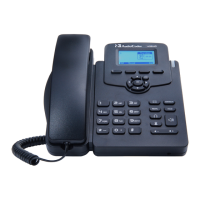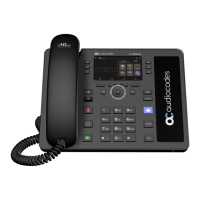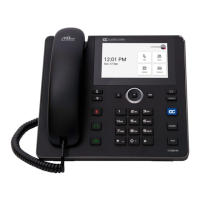Administrator's Manual 18. Configuring Dialing
Version 2.2.8 115 400HD Series IP Phones
18.5 Configuring Digit Maps and Dial Plans
Digit maps and Dial plans can be configured using the Web interface or Configuration File.
To configure digit map and dial plan using the Web interface:
1. Access the Dialing page (Configuration tab > Voice Over IP menu > Dialing).
Figure 18-6: Web Interface - Digit Map and Dial Plan
2. Configure the parameters using the table below as reference, and then click Submit.
To configure digit map and dial plan using the Configuration File:
• Use the table below as reference.
Note: Invalid Tokens will be ignored by the application.
Table 18-5: Digit Map and Dial Plan Parameters
Parameter Description
Digit Map
[voip/signalling/sip/digit_map]
Enables the administrator to predefine possible formats (or
patterns) for the dialed number. A match to one of the defined
patterns terminates the dialed number.
The valid value can be up to 256 characters.
There are two main formats for the digit map configuration.
The formats are distinguished by the separator ';' or '|'.
Using '|' separator: The following constructs can be used
in each numbering scheme:
Digit: A digit from 0 to 9.
DTMF: A digit, or one of the symbols A, B, C, D, #, or
*. Extensions may be defined.
Wildcard: The symbol x which matches any digit (0 to
9).
* Range: One or more DTMF symbols enclosed
between square brackets ([ and ]).
Sub range: Two digits separated by hyphen (-) which
matches any digit between and including the two. The
subrange construct can only be used inside a range
construct, i.e., between [ and ].
Position: A period (.) which matches an arbitrary
number, including zero, of occurrences of the
preceding construct.
For example:
[2-9]11|0|100|101|011xxx.|9011xxx.|1[2-9]xxxxxxxxx|91[2
-9]xxxxxxxxx|9[2-9]xxxxxx|*xx|[8]xxxx|[2-7]xxx
This example includes the following rules:
[2-9]11: 911 rule: 211, 311, 411, 511, 611, 711, 811,
911 are dialed immediately
0: Local operator rule: After dialing 0 the phone waits
T seconds and then completes the call automatically

